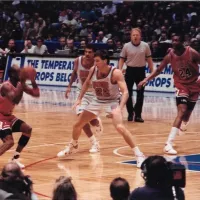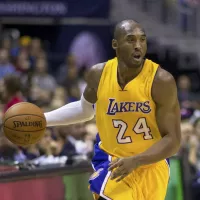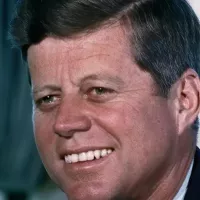Adidas AG is a German multinational corporation, the largest sportswear manufacturer in Europe and second-largest globally after Nike. Headquartered in Herzogenaurach, Bavaria, Germany, Adidas is the holding company for the Adidas Group, which includes a stake in Bayern Munich and Runtastic. In 2018, Adidas reported a revenue of €21.915 billion.
July 1924: Dassler Brothers Shoe Factory formation
In July 1924, Rudolf Dassler joined his brother Adolf Dassler's business, forming the "Dassler Brothers Shoe Factory" (Gebrüder Dassler Schuhfabrik).
1924: Dassler Brothers Shoe Factory
In 1924, Adolf Dassler was joined by his elder brother Rudolf to form the Gebrüder Dassler Schuhfabrik (Dassler Brothers Shoe Factory).
May 1933: Dassler brothers join the Nazi Party
In May 1933, both Adolf and Rudolf Dassler joined the Nazi Party (NSDAP).
1935: Adolf Dassler takes rank in the Hitler Youth
From 1935 until the end of the war, Adolf Dassler took the rank of Sportwart in the Hitler Youth.
1936: Jesse Owens uses Dassler spikes
In 1936, Adolf Dassler persuaded U.S. sprinter Jesse Owens to use his handmade spiked running shoes at the Summer Olympics.
1936: Jesse Owens wears Dassler shoes at the Olympics
In 1936, Dassler persuaded U.S. sprinter Jesse Owens to use his handmade spikes at the 1936 Summer Olympics, leading to worldwide recognition after Owens won four gold medals.
1942: Forced labour used at Dassler factory
From 1942 to 1945, at least nine forced labourers were working at both sites of the Dassler company.
1943: Shoe production ceased at Dassler factory
In 1943, shoe production at the Dassler factory was forced to cease operations and the facilities were used to manufacture anti-tank weapons.
1945: Forced labour used at Dassler factory
From 1942 to 1945, at least nine forced labourers were working at both sites of the Dassler company.
1945: Dassler factory spared from destruction
In 1945, the Dassler factory, which had been used for anti-tank weapon production during World War II, was nearly destroyed by US forces but was spared after Adolf Dassler's wife convinced the soldiers that the company was only interested in manufacturing sports shoes.
1947: Dassler brothers split
In 1947, the Dassler brothers split after a breakdown in their relationship.
August 1949: Adidas AG registered
On August 18, 1949, Adolf Dassler registered his company as Adidas AG.
1949: Adolf created Adidas
In 1949, after a fallout with his brother Rudolf, Adolf Dassler created Adidas, a sportswear and footwear company.
1952: Josy Barthel wins Olympic gold in Puma shoes
At the 1952 Summer Olympics, Josy Barthel of Luxembourg won Puma's first Olympic gold in the 1500 metres, held in Helsinki, Finland.
1952: Three stripes branding
In 1952 Adidas bought the three stripes branding from Finnish sports company Karhu Sports for the equivalent of €1,600 and two bottles of whiskey.
1952: Adidas acquired its signature 3-stripe logo
In 1952, Adidas acquired its signature 3-stripe logo from the Finnish athletic footwear brand Karhu Sports for two bottles of whiskey and the equivalent of €1600.
1960: Armin Hary wears both Adidas and Puma at Olympics
At the 1960 Summer Olympics, Puma paid German sprinter Armin Hary to wear Pumas in the 100 meter sprint final. Hary won gold in Pumas, but then laced up Adidas for the medals ceremony, leading to Adidas banning the Olympic champion.
1970: "Pelé Pact"
In 1970 the Dassler brothers made the "Pelé Pact", agreeing not to sign a sponsorship deal with Pelé for the 1970 FIFA World Cup but Puma broke the pact and signed him.
1971: Trefoil logo designed
In 1971, the Trefoil logo was designed.
1972: Munich Olympics
Adidas created the SL 72 originally for the 1972 Munich Olympics where the massacre of 11 Israeli athletes took place.
1972: Trefoil logo launched
In 1972, the Trefoil logo was launched in time for the 1972 Summer Olympics held in Munich.
1987: Death of Horst Dassler
In 1987, Adolf Dassler's son, Horst Dassler, died.
1990: Adidas bought by Bernard Tapie
In 1990, after a period of trouble, Adidas was bought by French industrialist Bernard Tapie for ₣1.6 billion.
1992: Crédit Lyonnais mandated to sell Adidas
In 1992, unable to pay the loan interest, Tapie mandated the Crédit Lyonnais bank to sell Adidas.
1993: Louis-Dreyfus increases revenue
From 1993 through 2000, as CEO of Adidas, Louis-Dreyfus quadrupled revenue to €5.84 billion.
1993: Tapie no longer owns Olympique de Marseille
Until 1993, Tapie had owned Olympique de Marseille.
1994: Robert Louis-Dreyfus becomes CEO of Adidas
In 1994, Robert Louis-Dreyfus became the new CEO of Adidas.
1994: SOS Children's Villages becomes main beneficiary
In 1994, combined with FIFA Youth Group, SOS Children's Villages became the main beneficiary.
1997: Tapie serves prison sentence
During 1997, Tapie served 6 months of an 18-month prison sentence in La Santé prison in Paris.
1997: Adidas becomes the British and Irish Lions kit supplier
From 1997, Adidas was the kit supplier for the British and Irish Lions.
1997: Adidas AG acquired the Salomon Group
In 1997, Adidas AG acquired the Salomon Group who specialized in ski wear, and its official corporate name was changed to Adidas-Salomon AG. With this acquisition Adidas also acquired the TaylorMade golf company and Maxfli, which allowed them to compete with Nike Golf.
1997: Introduction of the "three bars" logo
In 1997, Adidas introduced the "three bars" logo, designed by Peter Moore.
1998: Adidas sued the NCAA
In 1998, Adidas sued the NCAA over their rules limiting the size and number of commercial logos on team uniforms and team clothing. Adidas withdrew the suit, and the two groups established guidelines as to what three-stripe designs would be considered uses of the Adidas trademark.
February 2000: Crédit Lyonnais sold Adidas to Louis-Dreyfus
In February 2000, Crédit Lyonnais sold Adidas to Louis-Dreyfus for 4.485 billion francs.
2000: Louis-Dreyfus announces resignation
In 2000, Robert Louis-Dreyfus announced he would resign the following year, due to illness.
2001: Previous Reebok deal put in place
In 2001, a previous Reebok deal had been put in place for 10 years before Adidas took over in April 2006.
July 2002: Kobe Bryant parts ways with Adidas
In July 2002, Kobe Bryant's endorsement with Adidas, including his first signature shoe, the Adidas Equipment KB8, concluded.
2003: Adidas sues Fitness World Trading
In 2003, Adidas filed a lawsuit in a British court challenging Fitness World Trading's use of a two-stripe motif similar to Adidas's three stripes. The court ruled that Fitness World's use was infringing.
September 2004: Adidas by Stella McCartney line launched
In September 2004, English fashion designer Stella McCartney launched a joint-venture line with Adidas, establishing a sports performance collection for women called "Adidas by Stella McCartney".
May 2005: Adidas sells Salomon Group
On May 3, 2005, Adidas announced that they had sold their partner company Salomon Group to Amer Sports of Finland for €485 million.
August 2005: Adidas to buy Reebok
In August 2005, Adidas declared its intention to buy Reebok for $3.8 billion (US$).
November 2005: Adidas releases new version of Adidas 1
On November 25, 2005, Adidas released a new version of the Adidas 1 with an increased range of cushioning and a new motor with 153 percent more torque.
2005: Workers fired after striking for better pay
At the Panarub factory in Java in 2005, 33 workers were fired after striking for better pay.
January 2006: Adidas takeover of Reebok completed
In January 2006, the Adidas takeover of Reebok was completed, bringing Adidas business sales closer to those of Nike in North America.
April 2006: Adidas becomes official NBA clothing provider
In April 2006, Adidas announced an 11-year deal to become the official NBA clothing provider.
2006: Adidas rejects suppliers supporting unions
Between 2006 and 2007, Adidas allegedly rejected many of its suppliers that supported unions, favoring subcontractors with worse labour rights records.
2007: Adidas rejects suppliers supporting unions
Between 2006 and 2007, Adidas allegedly rejected many of its suppliers that supported unions, favoring subcontractors with worse labour rights records.
2010: Kevin Garnett and Gilbert Arenas end Adidas endorsements
In 2010, Kevin Garnett opted out of his contract with Adidas, and Gilbert Arenas's endorsement also ended.
January 2011: PT Kizone factory closes
In January 2011, the PT Kizone factory in Indonesia, which produced products for Adidas, Nike, and the Dallas Cowboys, closed, owing 2,686 workers $3 million in severance pay and benefits.
November 2011: Adidas to acquire Five Ten
In November 2011, Adidas announced that it would acquire outdoor action sport performance brand Five Ten through a share purchase agreement.
June 2012: Adidas cancels Jeremy Scott shackle shoes
In June 2012, Adidas faced controversy after posting a picture of Jeremy Scott-designed shoes containing shackles on their Facebook page. The planned shoe line was intended for release in July, but the company cancelled the product following public outcry.
July 2012: Activists protest low Adidas wages
In July 2012, activists in London replaced Adidas price tags with 34p ones, referencing the low hourly wage of Indonesian workers. Labour Behind the Label claimed workers earned only £10 a week.
2012: Highest revenues reported by Adidas
By the end of 2012, Adidas was reporting their highest revenues ever and Chief Executive Herbert Hainer expressed optimism for the year ahead.
2013: End of Adidas deal with British and Irish Lions
In 2013, Adidas's tenure as the kit supplier for the British and Irish Lions concluded.
April 2014: Strike at Yue Yuen shoe factory
In April 2014, one of the biggest strikes on mainland China took place at the Yue Yuen Industrial Holdings Dongguan shoe factory, which produces for Adidas, amongst others.
January 2015: Adidas Confirmed app launched
In January 2015, Adidas launched the footwear industry's first reservation mobile app. The Adidas Confirmed app allows consumers to get access to and reserve the brand's limited edition sneakers by using geo targeting technology.
March 2015: Adidas unveils 2015 McDonald's All-American uniforms
On 24 March 2015, Adidas and McDonald's unveiled the 2015 McDonald's All-American uniforms. For the third year in a row, players will be wearing short-sleeved jerseys, made with the same lightweight and breathable material as the ones used in the NBA.
August 2015: Adidas acquires Runtastic
In August 2015, Adidas acquired fitness technology firm Runtastic for approximately $240 million.
August 2015: James Harden signs with Adidas
In August 2015, James Harden signed a 13-year contract with Adidas reportedly worth US$200 million, leaving Nike.
2016: Adidas sues Skechers
In 2016, Adidas filed lawsuits against Skechers for allegedly duplicating the Stan Smith design and producing Adidas replicas like "Springblade".
May 2017: Adidas sells TaylorMade golf company
In May 2017, Adidas sold TaylorMade golf company to KPS Capital Partners for $425 million.
2017: James Gatto indicted in NCAA corruption scandal
In 2017, Adidas executive James Gatto was indicted in the NCAA Division I men's basketball corruption scandal.
2017: Adidas becomes official outfitter of the NHL
In 2017, Adidas signed an agreement with the National Hockey League (NHL) to be the official outfitter of uniforms and licensed apparel.
2018: Adidas pulls Soviet-themed items after social media criticism
In 2018, Adidas promoted a line of Soviet-themed items which were subsequently removed from the market after a social media outcry.
2018: Adidas's revenue for 2018
In 2018, Adidas's revenue was listed at €21.915 billion.
June 2020: Karen Parkin resigns from Adidas
In June 2020, Karen Parkin, head of global human resources at Adidas, voluntarily stepped down following concerns raised by black employees about her handling of racism and discrimination in the workplace.
2022: Cotton from Xinjiang identified in Adidas shirts
In 2022, researchers from Nordhausen University of Applied Sciences identified cotton from Xinjiang in Adidas shirts.
2022: Adidas supplies clothing to Super Rugby franchises
Up until 2022, Adidas was the clothing sponsor for the New Zealand Rugby Union and supplied clothing to all Super Rugby franchises, a selection of domestic teams and national referees.
2023: End of Adidas agreement with NHL
The Adidas agreement with the NHL will continue until the 2023-24 season.
July 2024: Adidas apologizes and withdraws Bella Hadid campaign
In July 2024, Adidas withdrew and apologized for their advertising campaign starring Bella Hadid for the SL 72.
Mentioned in this timeline

Basketball is a team sport played on a rectangular court...

Kobe Bryant a legendary shooting guard dedicated his -year NBA...
McDonald's is an American multinational fast food chain As of...
Facebook is a social media and networking service created in...

Virat Kohli is a prominent Indian international cricketer formerly captaining...
The Union of Soviet Socialist Republics USSR existed from to...
Trending

Gene Simmons also known as The Demon was the bassist and co-lead singer of the rock band Kiss He co-founded...
26 days ago New handbag, dishes, snacks, drinks, and holiday mocktails appear at Disney Springs.

6 months ago Ron Howard Reflects on 'The Studio' Scene with Bryan Cranston, Sarah Polley, and Dave Franco.
5 months ago Millennials Revolt: Coffee Badging Protests Return to Office Policies, Workplace Trends Emerge

7 months ago Koepka and DeChambeau attend Ryder Cup dinner, Bradley sees new side of golf.

9 months ago Cody Rhodes Crushes John Cena After Promo Battle on WWE Raw, March 31, 2025
Popular

Tucker Carlson is an American conservative political commentator known for...

Candace Owens is an American conservative political commentator and author...

XXXTentacion born Jahseh Dwayne Ricardo Onfroy was a controversial yet...

Ben Shapiro is a prominent American conservative political commentator media...

William Franklin Graham III commonly known as Franklin Graham is...

John F Kennedy JFK was the th U S President...
